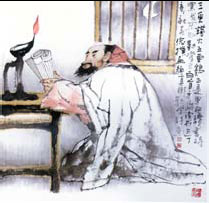What's new
An insider's guide to market
The Chinese art market has been hot for years. Now China Art Market Research Report, an annual insider's guide, will give art enthusiasts a closer look at local art market trends. The in-depth report, based on first-hand data, is prepared by the Art Market Research Center, with the China Central Academy of Fine Arts in Beijing.
Its first installment, 2006-2007 China Art Market Research Report, deals not only with trends in the Chinese art market but also analyzes gallery businesses and artwork auctions.
It also touches upon the market performances of eye-catching artists whose works have sold at record prices, such as Zhang Xiaogang, Yue Minjun and Wang Huaiqing.
Examining examinations

For over 1,300 years until 1905, the keju (imperial examination system) served as an effective means to select talent for civil service positions during the feudal dynasties.
The Shanghai Museum of Chinese Keju (Imperial Examination) System is holding an exhibition of ink art about the keju.
Added to the vintage photos, charts, reproduced examination desks, wax models of ancient scholars in their private studies and video programs (with English translations), the art exhibition features 150 Chinese ink paintings and works of calligraphy created by artists from 22 provinces, regions and municipalities, according to Shao Hui, vice-director of the museum.
Among the paintings and calligraphy works on show, some depict historical figures, such as the educator and thinker Confucius, Tang Dynasty general and calligrapher Yan Zhenqing, and Ming Dynasty scholar Cheng Yi. Others visualize well-known tales about how the keju affected the life of ordinary Chinese in ancient times. The exhibition runs until January 21.
Trees are a sign of the ties
The Worldwide United Chinese Association has begun another forestation project in Inner Mongolia Autonomous Region, donating saplings for over 1,000 hectares of land to improve the local ecosystem.
In 2002, the non-profit organization donated 30 million saplings to Inner Mongolia, and 1.5 million saplings to the Xinjiang Uygur Autonomous Region, and 500,000 saplings to Tai'an, East China's Shandong Province, with financial support from overseas Chinese entrepreneurs, scholars, and politicians, association head Xia Ronghuai said last week in Beijing.
The organization was 25 years old in December and is based in Los Angeles, the United States. It strengthens ties between overseas Chinese communities and the mainland, Xia said.
More art for the people
Art aficionados can do more than just peruse the 798 Art Zone for chic contemporary art. Take a look at Liulichang Traditional Art Street and Panjiayuan Antique Market for curios and collectibles.
The Beijing creative Industry Promotion Center, Fengtai District government and several other art institutions have recently launched the Jimei International Arts Production and Exchange Center in southern Beijing.
Covering over 50,000 sq m, the art center comprises galleries selling Chinese ink paintings, folk art works and handicrafts, as well as sculptures and copies of classic oil works.
The art center also serves as a platform for seasonal art fairs, auctions, seminars, and visual art training courses for young children, according to Zhao Jianguo, general manager of the art zone.
China Daily
(China Daily 01/09/2008 page18)














